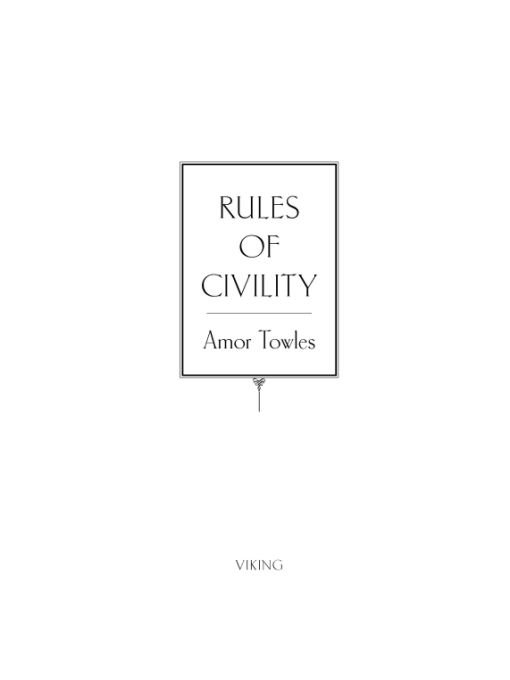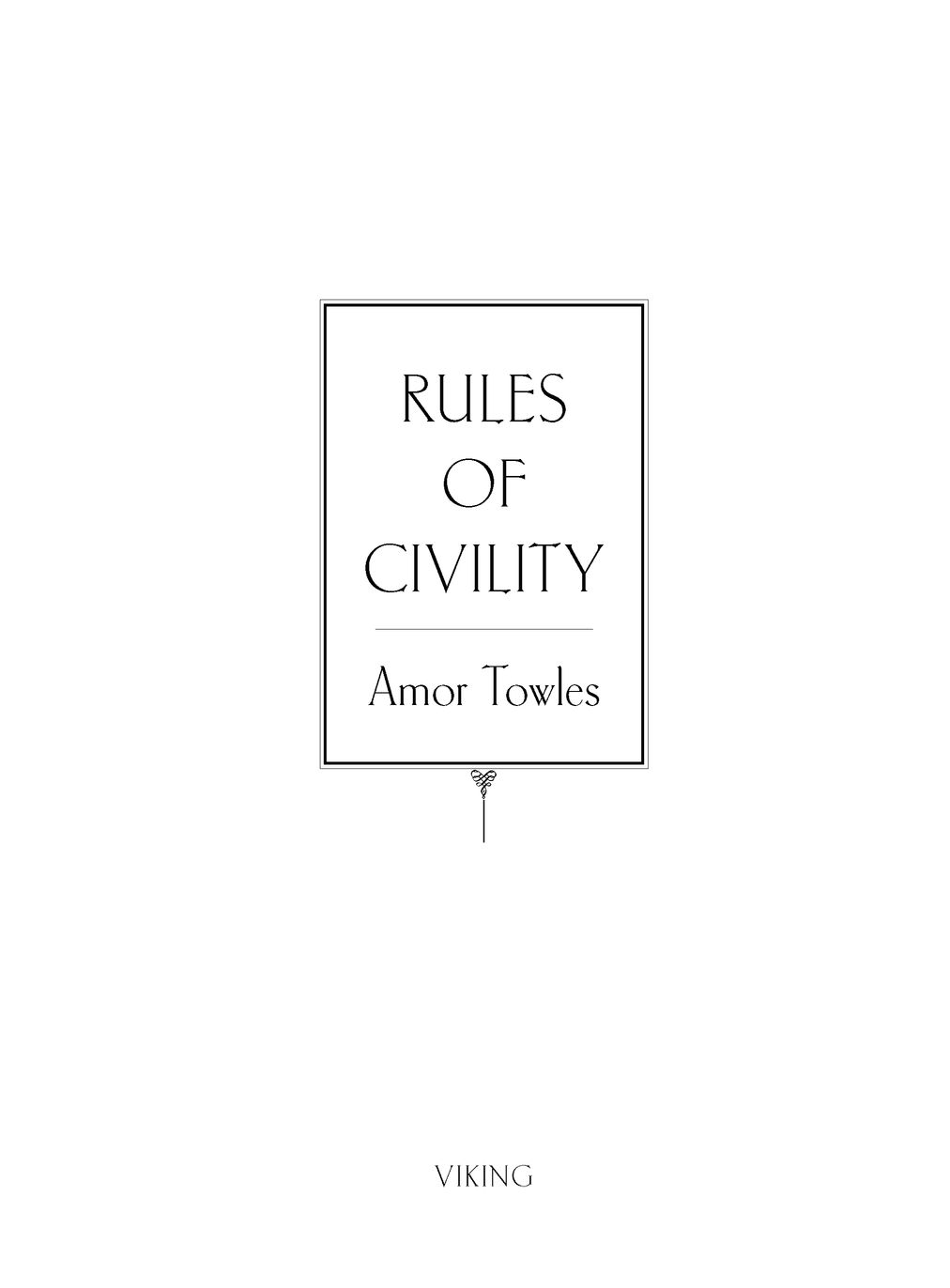Rules of Civility
Authors: Amor Towles



Table of Contents
Â
Â
Â
Â
Â
Â
VIKING
Published by the Penguin Group
Penguin Group (USA) Inc., 375 Hudson Street, New York, New York 10014, U.S.A. ⢠Penguin Group (Canada), 90 Eglinton Avenue East, Suite 700, Toronto, Ontario, Canada M4P 2Y3 (a division of Pearson Penguin Canada Inc.) ⢠Penguin Books Ltd, 80 Strand, London WC2R 0RL, England ⢠Penguin Ireland, 25 St. Stephen's Green, Dublin 2, Ireland (a division of Penguin Books Ltd) ⢠Penguin Books Australia Ltd, 250 Camberwell Road, Camberwell, Victoria 3124, Australia (a division of Pearson Australia Group Pty Ltd) ⢠Penguin Books India Pvt Ltd, 11 Community Centre, Panchsheel Park, New Delhiâ110 017, India ⢠Penguin Group (NZ), 67 Apollo Drive, Rosedale, Auckland 0632, New Zealand (a division of Pearson New Zealand Ltd) ⢠Penguin Books (South Africa) (Pty) Ltd, 24 Sturdee Avenue, Rosebank, Johannesburg 2196, South Africa
Â
Penguin Books Ltd, Registered Offices: 80 Strand, London WC2R 0RL, England
Â
First published in 2011 by Viking Penguin, a member of Penguin Group (USA) Inc.
Â
Copyright © Cetology, Inc., 2011
All rights reserved
Â
Grateful acknowledgment is made for permission to reprint an excerpt from “Autumn in New York” by Vernon Duke. © Copyright 1934 by Kay Duke Music.
Â
Photograph credits
Image copyright © The Metropolitan Museum of Art / Art Resource, NY
Page 11: The Metropolitan Museum of Art, Walker Evans Archive, 1994 (1994.253.622.5), © Walker Evans Archive, The Metropolitan Museum of Art ⢠Page 57: The Metropolitan Museum of Art, Walker Evans Archive, 1994 (1994.253.612.3), © Walker Evans Archive, The Metropolitan Museum of Art ⢠Page 147: The Metropolitan Museum of Art, Walker Evans Archive, 1994 (1994.253.514.1), © Walker Evans Archive, The Metropolitan Museum of Art ⢠Page 249: The Metropolitan Museum of Art, Walker Evans Archive, 1994 (1994.253.606.3), © Walker Evans Archive, The Metropolitan Museum of Art ⢠Page 313: The Metropolitan Museum of Art, Walker Evans Archive, 1971 (1971.646.18), © Walker Evans Archive, The Metropolitan Museum of Art
Â
Publisher's Note
This is a work of fiction. Names, characters, places, and incidents either are the product of the author's imagination or are used fictitiously, and any resemblance to actual persons, living or dead, business establishments, events, or locales is entirely coincidental.
Â
LIBRARY OF CONGRESS CATALOGING-IN-PUBLICATION DATA
Towles, Amor.
Rules of civility : a novel / Amor Towles.
p. cm.
ISBN : 978-1-101-51706-2
1. Young womenâFiction. 2. Upper classâNew York (State)âNew YorkâFiction. 3. Nineteen thirtiesâFiction. 4. Wall Street (New York, N.Y.)âFiction. 5. New York (N.Y.)âFiction. I. Title.
PS3620.O945R85 2011
813'.6âdc22
2011004118
Â
Â
Without limiting the rights under copyright reserved above, no part of this publication may be reproduced, stored in or introduced into a retrieval system, or transmitted, in any form or by any means (electronic, mechanical, photocopying, recording or otherwise), without the prior written permission of both the copyright owner and the above publisher of this book.
Â
The scanning, uploading, and distribution of this book via the Internet or via any other means without the permission of the publisher is illegal and punishable by law. Please purchase only authorized electronic editions and do not participate in or encourage electronic piracy of copyrightable materials. Your support of the author's rights is appreciated.
FOR MAGGIE,
MY COMET
MY COMET
Then saith he to his servants, The wedding is ready, but they which were bidden were not worthy. Go ye therefore into the highways, and as many as ye shall find, bid to the marriage. So those servants went out into the highways and gathered together all as many as they found, both bad and good: and the wedding was furnished with guests.
And when the king came in to see the guests, he saw there a man which had not on a wedding garment: And he saith unto him, Friend, how camest thou in hither not having a wedding garment? And he was speechless. Then said the king to the servants, Bind him hand and foot, and take him away, and cast him into outer darkness; there shall be weeping and gnashing of teeth. For many are called, but few are chosen.
Â
âMatthew 22:8 â 14
Preface
On the night of October 4th, 1966, Val and I, both in late middle age, attended the opening of
Many Are Called
at the Museum of Modern Artâthe first exhibit of the portraits taken by Walker Evans in the late 1930s on the New York City subways with a hidden camera.
Many Are Called
at the Museum of Modern Artâthe first exhibit of the portraits taken by Walker Evans in the late 1930s on the New York City subways with a hidden camera.
Â
It was what the social columnists liked to refer to as “a superlative affair.” The men were in black tie, echoing the palette of the photographs, and the women wore brightly colored dresses hemmed at every length from the Achilles tendon to the top of the thigh. Champagne was being served off little round trays by young unemployed actors with flawless features and the grace of acrobats. Few of the guests were looking at the pictures. They were too busy enjoying themselves.
Â
A drunken young socialite in pursuit of a waiter stumbled and nearly knocked me to the floor. She wasn't alone in her condition. At formal gatherings, somehow it had become acceptable, even stylish, to be drunk before eight.
But perhaps that wasn't so hard to understand. In the 1950s, America had picked up the globe by the heels and shaken the change from its pockets. Europe had become a poor cousinâall crests and no table settings. And the indistinguishable countries of Africa, Asia, and South America had just begun skittering across our schoolroom walls like salamanders in the sun. True, the Communists were out there, somewhere, but with Joe McCarthy in the grave and no one on the Moon, for the time being the Russians just skulked across the pages of spy novels.
So all of us were drunk to some degree. We launched ourselves into the evening like satellites and orbited the city two miles above the Earth, powered by failing foreign currencies and finely filtered spirits. We shouted over the dinner tables and slipped away into empty rooms with each other's spouses, carousing with all the enthusiasm and indiscretion of Greek gods. And in the morning, we woke at 6:30 on the dot, clearheaded and optimistic, ready to resume our places behind the stainless steel desks at the helm of the world.
Â
The spotlight that night wasn't on the photographer. In his midsixties, withered by an indifference to food, unable to fill out his own tuxedo, Evans looked as sad and nondescript as a retiree from General Motors middle management. Occasionally, someone would interrupt his solitude to make a remark, but he spent whole quarters of an hour standing awkwardly in the corner like the ugliest girl at the dance.
Â
No, all eyes were not on Evans. Instead, they were trained on a thin-haired young author who had just made a sensation by penning a history of his mother's infidelities. Flanked by his editor and a press agent, he was accepting compliments from a coterie of fans, looking like a sly newborn.
Val took in the fawning circle with a curious gaze. He could make $10,000 in a day by setting in motion the merger of a Swiss department store chain with an American missile manufacturer, but for the life of him, he couldn't figure how a tattletale could cause such a stir.
Always mindful of his surroundings, the press agent caught my eye and waved me over. I gave a quick wave back and took my husband's arm.
âCome on, sweetheart, I said. Let's look at the pictures.
We walked into the exhibition's less crowded second room and began working our way around the walls at an unhurried pace. Virtually all of the pictures were horizontal portraits of one or two subway riders seated directly across from the photographer.
Here was a sober young Harlemite in a gamely tilted bowler with a little French mustache.
Here was a four-eyed forty-year-old with a fur-collared coat and a wide-brimmed hat looking every bit the gangster's accountant.
Here were two single girls from the perfume counter at Macy's, solidly in their thirties, a little sour with the knowledge that their best years were behind them, riding with eyebrows plucked all the way to the Bronx.
Here a him; there a her.
Here the young; there the old.
Here the dapper; there the drab.
Â
Though taken more than twenty-five years earlier, the photographs had never been shown publicly. Evans apparently had some sort of concern for his subjects' privacy. This may sound strange (or even a little self-important) when you consider that he had photographed them in such a public place. But seeing their faces lined along on the wall, you could understand Evans's reluctance. For, in fact, the pictures captured a certain naked humanity. Lost in thought, masked by the anonymity of their commute, unaware of the camera that was trained so directly upon them, many of these subjects had unknowingly allowed their inner selves to be seen.
Anyone who has ridden the subway twice a day to earn their bread knows how it goes: When you board, you exhibit the same persona you use with your colleagues and acquaintances. You've carried it through the turnstile and past the sliding doors, so that your fellow passengers can tell who you areâcocky or cautious, amorous or indifferent, loaded or on the dole. But you find yourself a seat and the train gets under way; it comes to one station and then another; people get off and others get on. And under the influence of the cradlelike rocking of the train, your carefully crafted persona begins to slip away. The superego dissolves as your mind begins to wander aimlessly over your cares and your dreams; or better yet, it drifts into an ambient hypnosis, where even cares and dreams recede and the peaceful silence of the cosmos pervades.
Other books
Long Summer Nights by Kathleen O'Reilly
Stockholm Syndrome 2- 17 Black and 29 Red by Richard Rider
Elm Creek Quilts [13] The Quilter's Kitchen by Jennifer Chiaverini
In Firm Pursuit by Pamela Samuels-Young
TangledBound by Emily Ryan-Davis
Sex, Bombs and Burgers by Peter Nowak
Kill Them Wherever You Find Them by David Hunter
Repairman Jack [07]-Gateways by F. Paul Wilson
Winter Wishes (Sharing Space #5) by Perez, Nina
Sweet Alien by Sue Mercury
